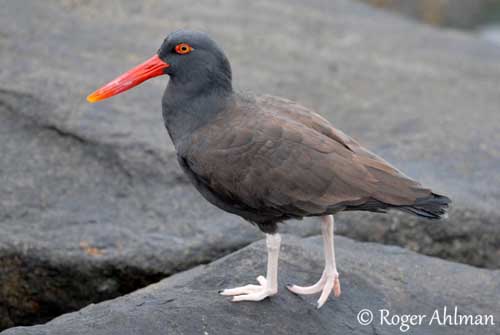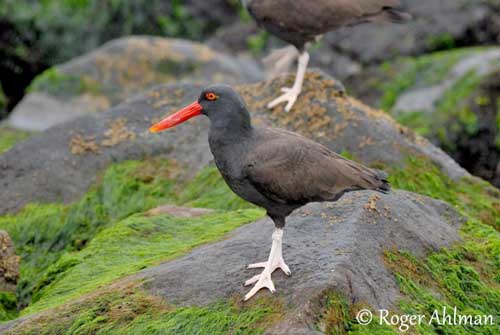
Fr: Huîtrier noir
All: Südamerikanischer-Austernfischer
Esp: Ostrero Negro Suramericano, Pilpilén negro, Ostrero Negro
Ita: Beccaccia di mare del Sudamerica
Nd: Zuid-Amerikaanse Zwarte Scholekster
Sd: Sydamerikansk strandskata
Port: Piru-piru-preto-sulamericano
Photographers:
Roger Ahlman
Pbase Galleries Peru and Ecuador
John Anderson
John Anderson Photo Galleries
Otto Plantema
Trips around the world
Text by Nicole Bouglouan
Sources:
HANDBOOK OF THE BIRDS OF THE WORLD Vol 3 by Josep del Hoyo-Andrew Elliott-Jordi Sargatal - Lynx Edicions - ISBN : 8487334202
SHOREBIRDS by Peter Hayman, John Marchant and Tony Prater – Christopher Helm – 1986 – ISBN: 0747014035
BirdLife International (BirdLife International)
Blackish Oystercatcher
Haematopus ater
Charadriiformes Order – Haematopodidae Family
INTRODUCTION:
The Blackish Oystercatcher is a South American monotypic species, also present in the Falklands. It is usually seen foraging on rocky shores where its dark plumage blends into the environment. It forages, nests and roosts in this type of habitat. This species is the only resident oystercatcher with black plumage in South America.
DESCRIPTION OF THE BIRD:
Biometrics:
Length: 43-45 cm
Weight: 585-708 g
Bill length: 65-84 mm
The adult has very dark plumage overall, with brownish back and upperwing, and black head, neck, tail and underparts.
The long, heavy bill is orange-red, more yellow at tip. It can be fairly broad and blade-shaped. The eyes are bright yellow in adults, surrounded by conspicuous, bare, orange-red eyering. Legs and feet are pale pink. There is a small web between outer and middle toes.

The female resembles male but she is larger with larger bill.
We can see some white-edged feathers on belly outside the breeding season.
The juvenile shows buff scaling on the dark plumage, especially on mantle, scapulars and coverts. The bill is duller than in adults, often with brown tip. The eyes are brown. Legs and feet are pale.
RANGE:
The Blackish Oystercatcher occurs in N Peru, S through Chile to Tierra del Fuego, and N up Atlantic coast to SC Argentina. It is present in the Falklands too.
They may move N to extreme N Peru, NE Argentina and probably Uruguay.
We can see here on this picture, the first record for Ecuador, a juvenile (with brownish bill tip) observed in Chanduy, Santa Elena, mid-June 2013. Picture by Roger Ahlman.
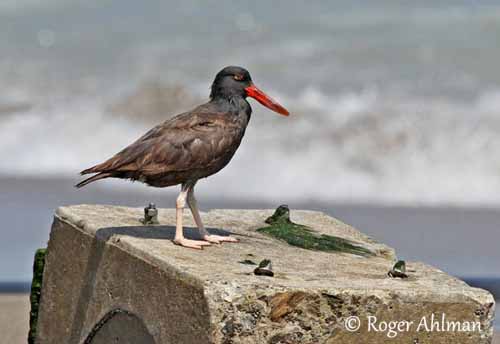
HABITAT:
The Blackish Oystercatcher frequents primarily the rocky shores. It feeds in intertidal zones along the rocky shorelines, in pools and on pebble beaches.
It rarely forages on sandy beaches, searching for mole crabs, but sometimes, that happens! Picture by Roger Ahlman.
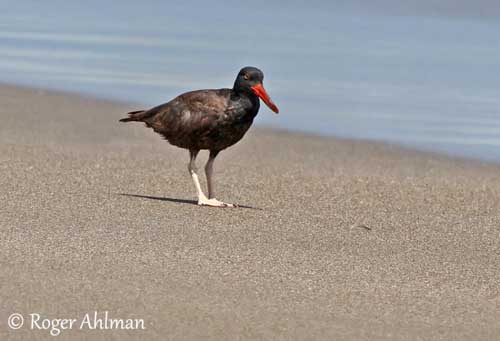
CALLS AND SONGS: SOUNDS BY XENO-CANTO
The Blackish Oystercatcher is often detected by its loud warning calls. Other calls include high-pitched piping whistles “pip” and longer “peeeeyeeee”.
The piping call is usually complex and far-carrying, starting with an accelerated trill and slowing down gradually. This call is often used in aggressive behaviour between neighbour pairs, or in territory defence, especially during the breeding season.
The piping call plays a role in species recognition when other similar species are present in the same area.
The song is sometimes given in duet. It is an excited chatter of piping whistles.
BEHAVIOUR IN THE WILD:
The Blackish Oystercatcher feeds on aquatic preys found on the rocky shores. It feeds mainly on mussels and limpets. It may use different ways to open this type of preys, such as hammering, prising, probing or stabbing with the bill.
They may form foraging groups after breeding.
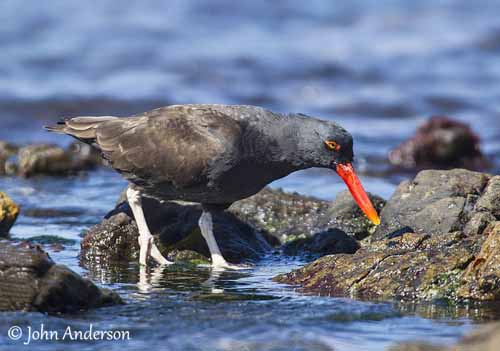
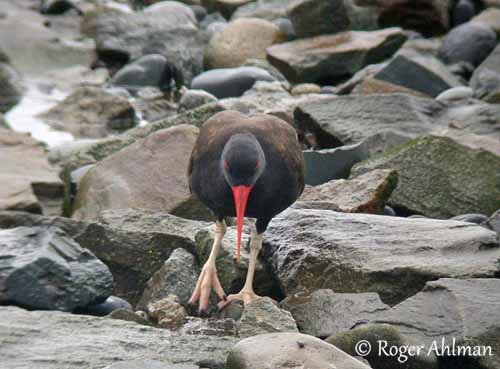
During the breeding season, the Blackish Oystercatcher is territorial. It is highly faithful to its breeding site.
They are monogamous and usually, the pair-bonds are long and strong. They produce only one brood per season, but a second clutch is laid if the first is lost. Both sexes share the nesting duties, although the male spends more time in territorial defence while the female is incubating.
Aerial displays are accompanied by calls. Other ritual postures enhance the brightly coloured eyering and bill.
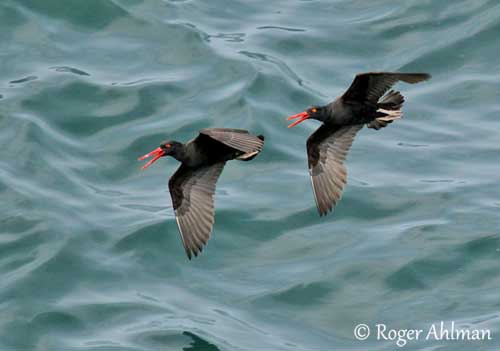
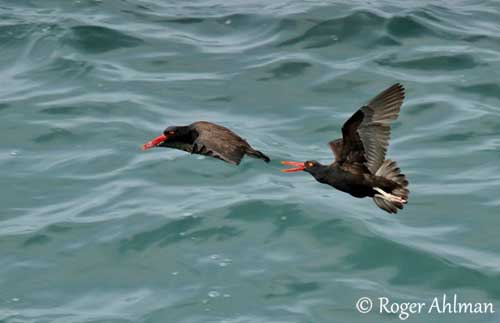
The Blackish Oystercatcher is mainly sedentary in its range. However, northwards movements by birds of Tierra del Fuego can be observed after breeding.
The flight is direct, thanks to the long, pointed wings.
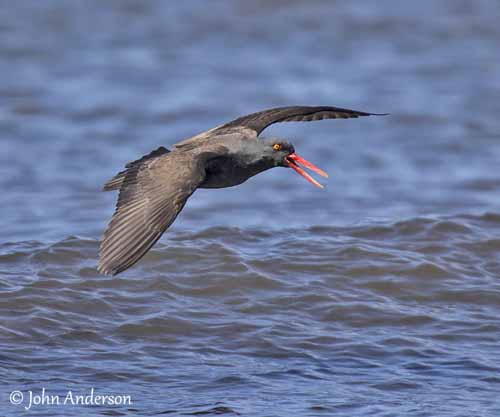
REPRODUCTION OF THIS SPECIES:
The laying period varies with the range, but usually starts in November in extreme S South America (Tierra del Fuego). In the Falklands, the breeding season occurs between late October and January.
The nest is s a scrape on the ground, a shallow depression often placed near the high tide mark, sometimes on bare rocks. This depression is lined with fragments of shells or rocks.
The female lays 1-2 greyish eggs with darker markings, making them invisible on the grainy background. The incubation period is unknown but probably ranges between 27 and 30 days, shared by both adults, but mainly by female. At hatching, the chicks have dull greyish-brown down with dark stripes, and the belly is mainly white. The chicks blend into the rocky habitat. They usually leave the nest within 24 hours after hatching. They are fed by both parents, included well after fledging, between 40 and 49 days after hatching. They may remain in family groups for several months.
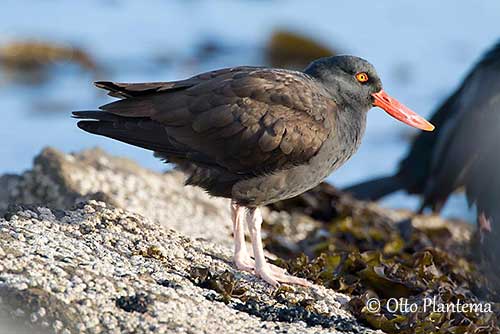
PROTECTION / THREATS / STATUS:
Eggs and chicks are vulnerable respectively to storms and predation by gulls and skuas.
The Blackish Oystercatcher has wide range in which it occurs at fairly low density. The Falkland’s population is estimated at about 5,000 breeding pairs. The global population size is unknown, ranging between 15,000 and 80,000 mature individuals.
This species is not currently threatened, and evaluated as Least Concern.
